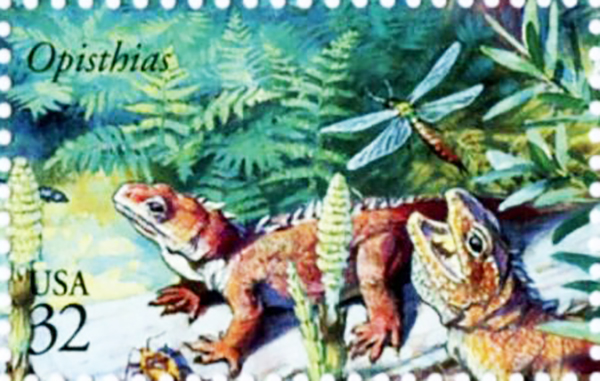Opisthias rarus Gilmore, 1905
Phylum: Chordata Haeckel, 1874
Subphylum: Vertebrata Cuvier, 1812
Classe: Reptilia Laurenti, 1768
Ordine: Sphenodontia Williston, 1925
Famiglia: Sphenodontidae Cope, 1870
Genere: Opisthias ilmore 1909
Descrizione
L'Opisthias è stato interpretato come un generalista, con la sua morfologia dei denti che indicava la capacità di elaborare materiale vegetale.
Diffusione
Visse nel Tardo Giurassico. I resti provengono dalla Formazione Morrison, nel Nord America, nelle zone stratigrafiche 2e 4-6. Altri resti suggeriti come strettamente correlati a Opisthias sono anche noti dalla Formazione Alcobaça del tardo Giurassico del Portogallo. Un cranio schiacciato non descritto (DINO 16454) dalla Formazione Morrison è stato attribuito a questo genere da alcune fonti, sebbene ciò sia stato fortemente contestato da altri. Una mascella inferiore è anche nota dalla Formazione Lulworth del Regno Unito, risalente al Berriasiano, che sembra essere distinta dalla specie tipo nordamericana. Un dentario frammentario, forse attribuibile a Opisthias, anche noto dal giacimento osseo di Angeac-Charente, risalente al Berriasiano, in Francia.
Bibliografia
–"Opisthias Gilmore 1909 (rhynchocephalian)". Paleobiology Database.
–Foster J (2007). "Table 2.1: Fossil Vertebrates of the Morrison Formation.". Jurassic West: The Dinosaurs of the Morrison Formation and Their World. Indiana University Press. pp. 58-59.
–Herrera-Flores, J.A.; Stubbs, T.L.; Sour-Tovar, F. (2022). "Redescription of the type specimens for the Late Jurassic rhynchocephalian Opisthias rarus and a new specimen of Theretairus antiquus from Quarry 9, Morrison Formation, Wyoming, USA". Acta Palaeontologica Polonica. 67 (3): 623-630.
–Foster J (2007). "Appendix". Jurassic West: The Dinosaurs of the Morrison Formation and Their World. Indiana University Press. pp. 327-329.
–Herrera-Flores JA, Stubbs TL (July 2018). "A re-evaluation of the taxonomy and diversity of the Late Jurassic sphenodontian Opisthias rarus Gilmore 1909 (Lepidosauria: Rhynchocephalia)[oral presentation]". 13th Symposium on Mesozoic Terrestrial Ecosystems and Biota.
–Malafaia, E.; Ortega, F.; Escaso, F.; Dantas, P.; Pimentel, N.; Gasulla, J. M.; Ribeiro, B.; Barriga, F.; Sanz, J. L. (2010). "Vertebrate fauna at the Allosaurus fossil-site of Andrés (Upper Jurassic), Pombal, Portugal". Journal of Iberian Geology. 36 (2): 193-204.
–DeMar, David G.; Jones, Marc E. H.; Carrano, Matthew T. (2022-12-31). "A nearly complete skeleton of a new eusphenodontian from the Upper Jurassic Morrison Formation, Wyoming, USA, provides insight into the evolution and diversity of Rhynchocephalia (Reptilia: Lepidosauria)". Journal of Systematic Palaeontology. 20 (1): 2093139.
–Herrera-Flores J (2020). Randall C (ed.). "New insights on an enigmatic sphenodontian jaw from Dorset". Proceedings of the Dorset Natural History and Archaeological Society. 141: 41-43.
–Ronan Allain, Romain Vullo, Lee Rozada, Jérémy Anquetin, Renaud Bourgeais, et al.. Vertebrate paleobiodiversity of the Early Cretaceous (Berriasian) Angeac-Charente Lagerstätte (southwestern France): implications for continental faunal turnover at the J/K boundary. Geodiversitas, Museum National d’Histoire Naturelle Paris, In press.
–Apesteguía S, Gómez RO, Rougier GW (October 2014). "The youngest South American rhynchocephalian, a survivor of the K/Pg extinction". Proceedings. Biological Sciences. 281 (1792): 20140811.

|
Data: 01/05/1997
Emissione: Il mondo dei dinosauri Stato: U.S.A. |
|---|